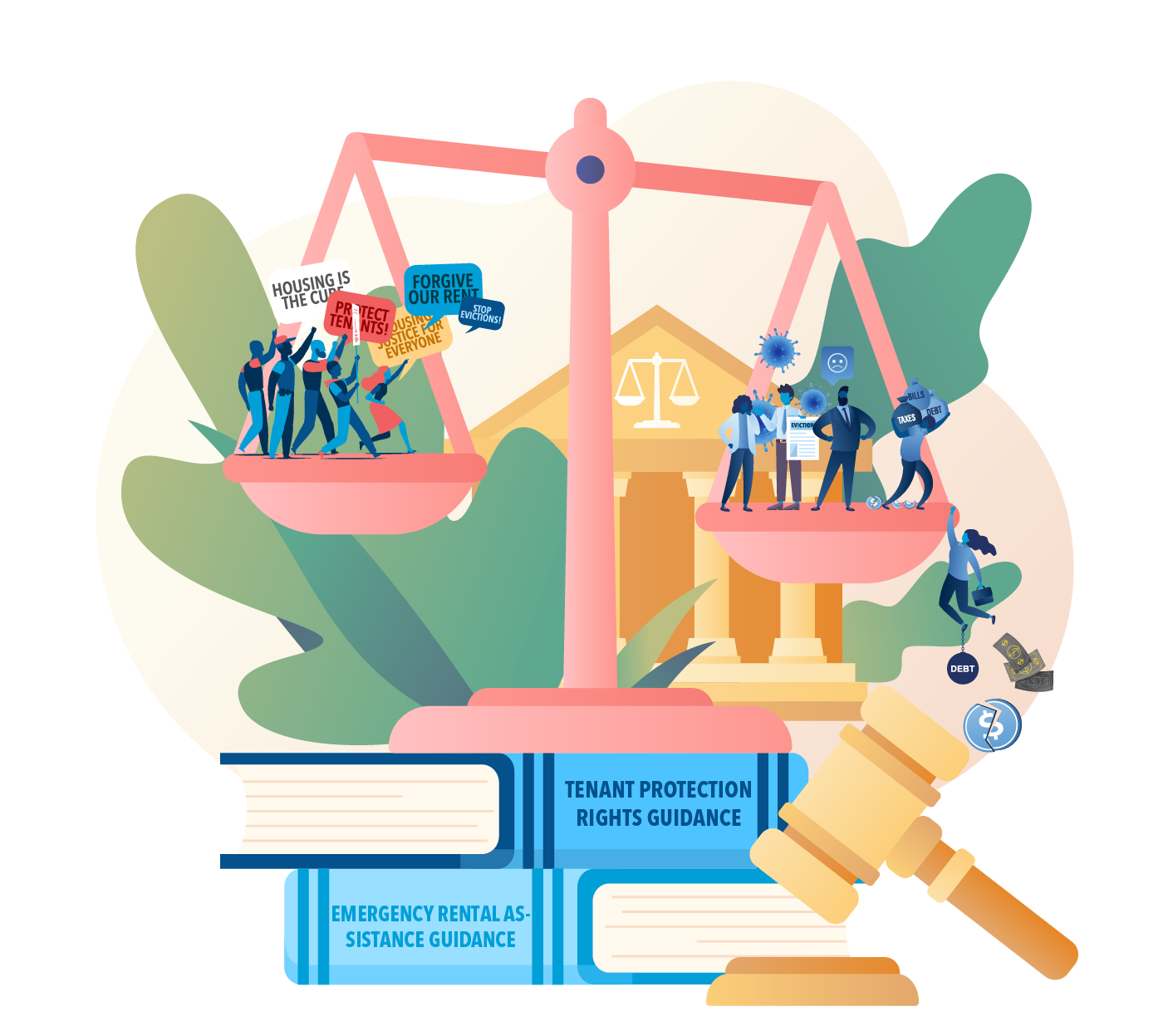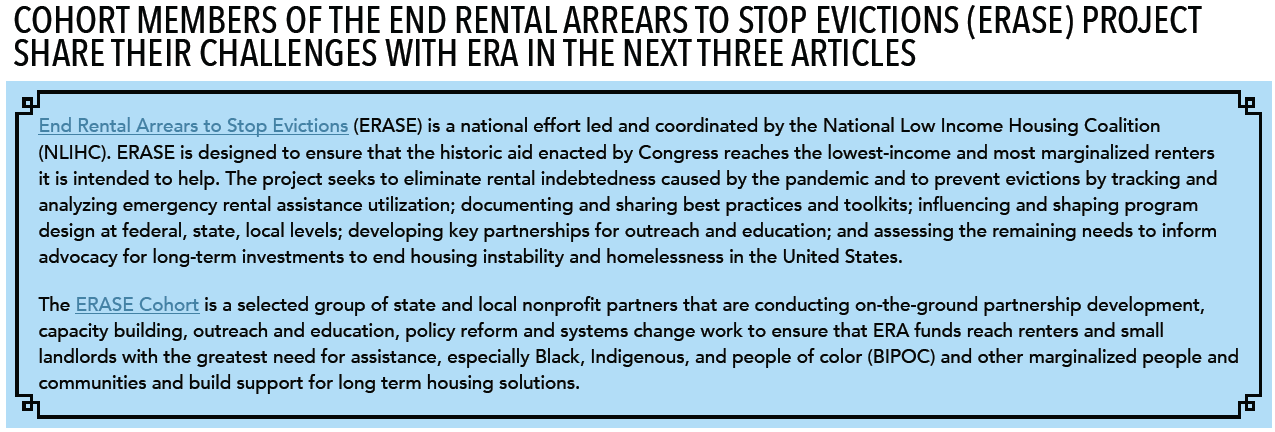https://nlihc.org/erase-project
Technological Barriers in Accessing Emergency Rental Assistance
by Jay Williams, program associate, Low Income Housing Coalition of Alabama
The Low Income Housing Coalition of Alabama (LIHCA) was created in the late 2000s to address the housing crisis impacting low-income Alabamians by creating and advocating for more affordable housing opportunities for Alabama’s most vulnerable. When the Emergency Rental Assistance (ERA) program in Alabama was launched, LIHCA aimed to influence state and local programs to accelerate the use of ERA funding and to ensure the program was equitable. In our work, we discovered that technology played a huge role in deterring renters from applying for assistance. Historically, housing programs have been operated through the Alabama Housing Finance Authority (AHFA), but they mainly focused on programs for homeowners. AHFA’s interactions with renters are very limited, and that shows when you look at the agency’s original ERA program design.
By our analysis, Alabama’s ERA application lacks a renter-centered approach, leaving renters on their own to navigate a program and resources they know little about. Renters with little broadband access, or low technological proficiency, have an even harder time accessing ERA than other applicants. We believe a paper application would be most beneficial for these renters. While we wait for paper applications to be released, however, we are encouraging local partners to provide navigation services for renters who cannot access or fill out online applications. To increase the accessibility of the application, we also encouraged AHFA to make the application available in multiple languages. Application guidance needs to be available in several languages as well. One of LIHCA’s goals is to develop an application translating tool that will assist AHFA and other local programs in making ERA applications more accessible.
LIHCA is grateful for its growing connections with AHFA and other ERA administrators, and we will continue advocating for improvements in the ERA application process to make it more accessible to Alabamians. Approaching this work with a holistic lens is important because renters desperately need all systems to work together to bring about program improvements that directly impact them. When working with administrators and other partners, we recognize that values-based messaging is truly transformative. Through our work, we are now aware of the gaps in service. What we’ve learned has made it easier to address the issues renters care about the most.

The Challenges of Landlord Refusal
by Emma Anderson, housing outreach worker, KY Equal Justice
In Lexington, Kentucky, receiving Emergency Rental Assistance (ERA) funds depends on a landlord’s willingness to participate in the city’s Housing Stabilization Program. In my experience, this is a significant barrier to eviction prevention during the pandemic. There is a running list of landlords and management companies that have made it company policy to refuse any rental-assistance funding from the city. Many distressing cases have gone through our courts. One landlord did not complete their section of the rental-assistance application and then evicted a tenant when the application wasn’t completed by the court date. Another got tired of waiting for a check to process and evicted a tenant even though they had been approved for payment. Many landlords do not want to comply with the program rules, which require waiving late fees and veto their ability to evict until 35 days after a last payment. As a tenant, the most helpful action you can take is to push your city’s ERA program to adopt the guidelines created by the Department of the Treasury, such as the suggestion that programs pay tenants directly.
If you are in a city that does not allow direct payment to tenants, and your landlord has refused to accept ERA money, try to find someone to advocate on your behalf to your property manager. Make sure it is mentioned in court that your landlord refused the assistance, as this could be evidence in a future debt collection case. While doing door-to-door outreach, I met a young mother, Ms. M, who had applied for the rental assistance program several months before and had yet to hear back. Her landlord was tired of waiting and didn’t trust the program due to a mistake it had made in approving one of his tenants who did not actually qualify. Due to this experience, he had stopped accepting funds and evicted Ms. M. After contacting the landlord and talking him through the program, we succeeded in convincing him to accept the money if he could get written confirmation that Ms. M qualified. She was not evicted and her rent was paid through February. If you can find someone who knows the ERA program and has some connections, it is sometimes possible to negotiate with landlords!

Navigating the Confusion and Complexity of Court Data
by Margaret Haltom, Neighborhood Preservation, Inc.
With the end of the eviction moratorium, more and more tenants are seeking to navigate local court data and access basic information about their upcoming eviction hearings. Here in Memphis, Tennessee, we were among the first in the country to be left unprotected by the ending of the eviction moratorium: evictions resumed in March 2021, after a group of local landlord attorneys fought successfully to persuade a court to declare the ban on evictions unconstitutional in West Tennessee. Since then, we’ve seen COVID-19-related court delays cause confusion as tenants try to determine when their hearing is set, where to go, and what to say to the judge, while simultaneously maneuvering the Emergency Rental Assistance (ERA) process. Neighborhood Preservation, Inc. – a community partner providing tenant representation and eviction prevention for the Memphis and Shelby County ERA program – is working to provide tenant court notifications that fill in the gaps for tenants seeking to decipher court data.
Our initiative leverages public court data to notify as many tenants as possible about their upcoming eviction hearings and available ERA funds via postcards, email, and text notifications. Eviction hearings here are running three months behind schedule, as the courts have regularly had to close or limit the number of hearings each week due to COVID-19 outbreaks. Most tenants are unaware of the delays: their first court notice – a detainer warrant that arrives in the mail – notifies them of an upcoming hearing to be held two weeks later. This hearing date is just a placeholder; the actual hearing date is reset later through the mail. But tenants often go to court anyway on the day of the placeholder date. They take time off from work and pay $8 to park only to find out their hearing will be reset. Many tenants do not return for their actual court date, assuming that it too is incorrect. To help clarify the process for people, my organization is sending postcards to all tenants with court filings in the public record. The postcards explain the court delays, notify recipients about available ERA assistance, and provide a QR code to access the ERA application. Public records do not include tenants’ phone numbers or email addresses, but as soon as a tenant facing eviction applies for ERA, we have access to their contact information and can send them text and email notifications about their court case, including a link to their personal court records online and an explanation of what the court records mean. We provide other useful resources, too: information about what to wear, what to tell the judge about their ERA application, what to say to their landlord. Over the coming months, we will strengthen this system and plan to send text and email notifications to as many tenants in need as possible. Our goal is to create a hotline that any tenant facing eviction can use to receive regular updates and resources in preparation for their upcoming hearing.
